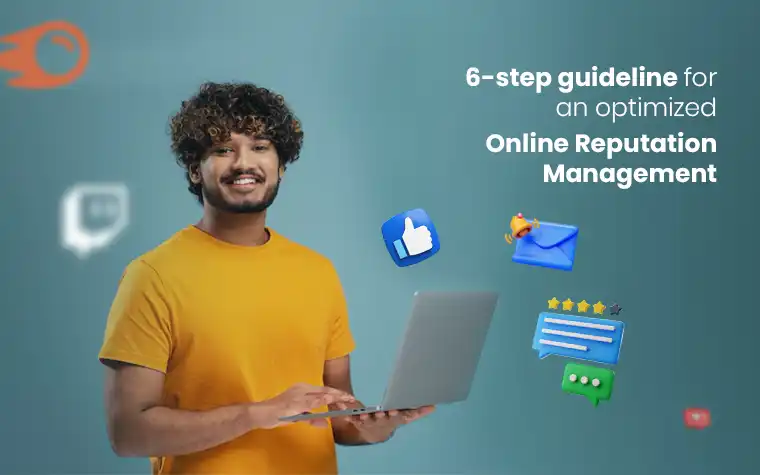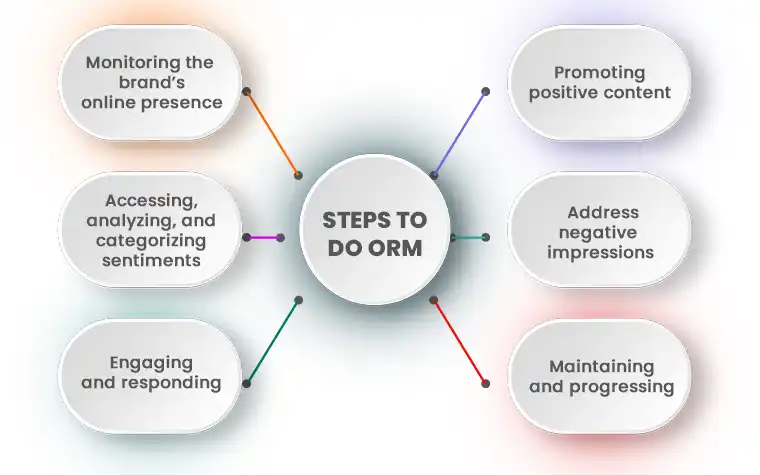
6-step guideline for an optimized Online Reputation Management
Witnessing a drastic growth in building brands online, Digital Marketing Trends in 2025 has become inevitable. With that said, online brand building has also become a home ground for brands with bad reputations and unethical frameworks.
So it’s essential to build authenticity and trustworthiness around the brand to bring in customers. In the era of everything being done online, it impacts the brand’s growth in the real world. However, trust is built, monitored, and managed online.
In this article, we’ll dive deep into Online Reputation Management and 6 crucial steps to optimize ORM for any brand.
What is ORM in Digital Marketing?
ORM is the process of supervising and handling how the business is projected on the online platforms. With the main focus of neutralizing negative impressions and resolving troubles faced, promoting the positive impressions of the business also comes under Online Reputation Management.
Key responsibilities of ORM are as follows:
- Responding to negative reviews
- Educating the customers
- Resolving complaints
- Managing search results
And, to get started, learning digital marketing as a whole can help optimize ORM for businesses. Apart from key responsibilities, ORM also supports and boosts the online presence of the brand. But before getting into ORM deeply, we need to know why it is so important in digital marketing.
Importance of Online Reputation Management?
Online Reputation Management in Digital Marketing is responsible for the brand’s credibility and reputation. ORM also influences the buying decisions of the consumer by more than 85%.
Additionally, it plays a major role in:
- Enhancing brand image by maintaining a favorable image online
- Boosting SEO performance with positive reviews and responses
- Managing the negative reputation to minimize long-term disruption
- Strengthening customer relationships by being interactive and accessible to the customers
- Keeping customers informed and insightful with the latest updates and new launches by the brand
Having discussed enough about the basics, let’s get into the technical aspects of ORM.
ORM in different media channels:
Based on how the media is acquired, it can be classified into 4 major types,
Paid Media:
It includes any form of media that requires payment. This includes:
- Google Ads
- PPC Ads
- Social Media Ads
Despite being an expensive choice, the Return on Investment (ROI) is considerably high when paid media is used. If you’re looking to take your skills further, consider enrolling in a Digital Marketing Certification Course to strengthen your understanding of ORM and more.
Earned Media:
Anything that the brand receives from a third party without having to pay comes under earned media.
This also includes:
- Press coverage
- Blog posts from other brands/sites
- Reviews on external sites
- Forum discussions
Owned Media:
Any media that’s controlled and monitored by the brand itself comes under owned media. Websites and email Newsletters fall under this category of media.
Shared Media:
Anything that’s shared on social media platforms, either from the brand’s handle or not, is considered to be shared media. This includes complaints, comments(positive and negative), and ratings.
Despite having a vast difference in media types, ORM can be done with 6 steps for any brand using any of the above-mentioned media types.

6 Steps to do ORM
Step 1: Monitoring the brand’s online presence
Start by setting up alerts on Google Alerts or similar tools for the brand, products, and other key executives. Then, track online reviews on sites like Google, Yelp, or Glassdoor and social media mentions using tools like Hootsuite or Brandwatch. Also, check for search results for both text and images regularly.
Step 2: Accessing, analyzing, and categorizing sentiments
Segregate the mentions based on the emotions, like positive, negative, or neutral. Then try identifying trends in it, like similarities in comments and reviews. Simultaneously, focus on critical issues and try to understand the context before reacting to it.
Step 3: Engaging and responding
By responding quickly and thoughtfully, the brand’s trustworthiness is measured. Avoid being defensive and acknowledge the issues respectfully. Consider responding within 24 to 48 hours by default. Thank positive reviews to build loyalty, and take controversial issues or complaints offline, maybe with calls or personal emails.
Step 4: Promoting positive content
Publish blog posts, press releases, and success stories. This, in result, promotes a positive brand image. Apart from that, encourage satisfied customers to share a positive review, and use social media campaigns to promote favorable conditions online.
Step 5: Address negative impressions
If a comment or post violates policies, a removal request can be made. If not, try to outrank negative content with high-quality SEO content. Keep learning from criticisms and improve internally. Most importantly, avoid being aggressive on the internet, which might lead to long-term disruption to the brand image.
Step 6: Maintaining and progressing
Proactively ask for feedback after customer interaction. Considering ORM a continuous process, rather than a one-time process, keep monitoring it. Update contents regularly to consistently maintain high rankings. Also, maintain a consistent tone in communicating across all media platforms.
Conclusion:
In 2025, competition is fierce. Upskilling and reskilling for career growth is not just beneficial—it’s essential to staying ahead. With Digital Marketing experiencing an all-time high in 2025, it’s also becoming highly competitive. To stand out from the emerging competition, it becomes mandatory to stay beyond the standards and have a first-class customer relationship, this is where ORM comes into play. Thus, understanding ORM strategies becomes essential to Master Digital Marketing in 2025.
Both positions are highly sought after in fields including IT, marketing, finance, and health. Next to follow in this list of In-demand tech careers is ‘Cybersecurity’



